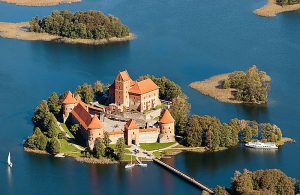Pre-Conference Tour 2017
IARF EME traditionally organizes pre-conference tours for interested participants. In 2016 we travelled through Macedonia and Albania. The 2017 tour will begin three days before the conference, that is on Friday the 8th. We will depart from Warsaw Airport at 1 pm. The fee is 310 EUR and is all-inclusive. You may register using the Conference Registration Form. Below follows a map and a plan of the tour (it may change slightly).
Route
Click here to see the map in a new window.
Day 1
We depart from Warsaw Aiport by mini bus and proceed in the direction of Bialystok. There we will make a stop in Tykocin, a neighbouring town famous for its Jewish district and two synagogues (now serving as museums). We will walk through the historic district, eat lunch at a restaurant serving Jewish cuisine, and see the museum in the Old Synagogue. Next we will travel to Kruszyniany, a Tatar village in the vicinity of Bialystok located virtually on the border of Poland and Belarus in the serene landscape of rural Podlasie with its fields, forests and old cottages. We will spend the night at a B&B that also serves as a Tatar cultural center run by members of the local Tatar community, Zajazd Tatarski. There we will be able to eat an elaborate dinner and taste many local dishes while enjoying some ethnic music.
Day 2
After breakfast we will walk a little through the countryside and see the two iconic wooden mosques of the region – in Kruszyniany and Bohoniki – and depart in the direction of Lithuania, stopping in Sokolka to see the museum with exhibitions devoted to Tatars, local history and ethnography. In the evening we will arrive in Trakai, Lithuania, and stay there for two nights.
Day 3
We will spend most of the day in Trakai, whose notable feature … is that the town was built and preserved by people of different nationalities. Historically, communities of Karaims, Tatars, Lithuanians, Russians, Jews and Poles lived here. We will see the impressive Trakai Island Castle and the part of the town where the Karaites live and worship with traditional houses and the kenesa (synagogue). In late afternoon we will drive to Vilnius, the capital of Lithuania and the second largest city in the Baltic states boasting a long history and rich cultural, religious and political legacy. Our walk will take us through the old town to see the most important landmarks.
Day 4
On our way back to Bialystok for the conference, we’ll stop in Suprasl to see the Orthodox Monastery and perhaps listen to chants performed by local monks. The monastery was founded in the XVI c. and has seen many tragic turns of local history and often changed hands as regonal powers gained and lost power. In the 16th c. it belonged to Byzantine (Greek) Catholics, a denomination that consisted of Orthodox Christians who acknowledged the authority of the pope after the Union of Brest; then, when Poland was paritions between neighbouring powers, and the Russian Empire ruled over this area, it was given to the Russian Orthodox Church. In the interbellum the new Polish state gave it to Roman Catholic Salesians. The People’s Republic of Poland, the state that emerged after WW II under Moscow’s protectorate, turned it into an agricultural academy. Finally, after the fall of communism, it was given to the Polish Orthodox Church.





